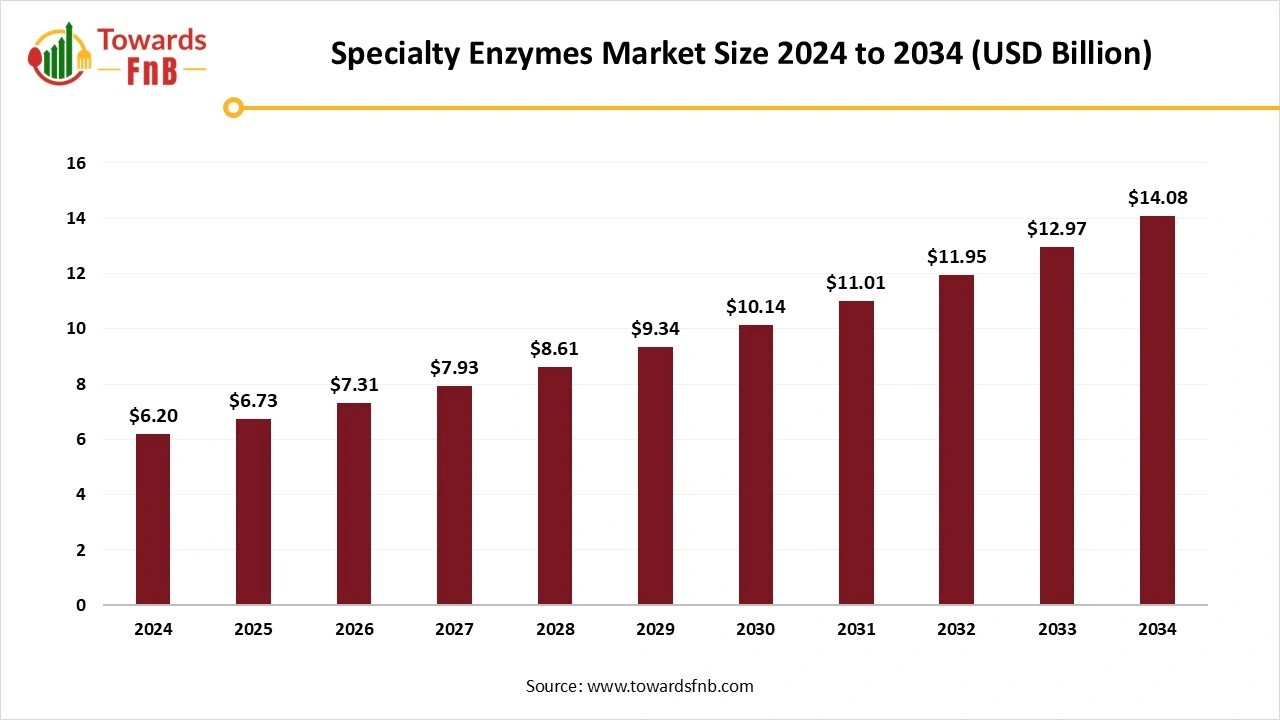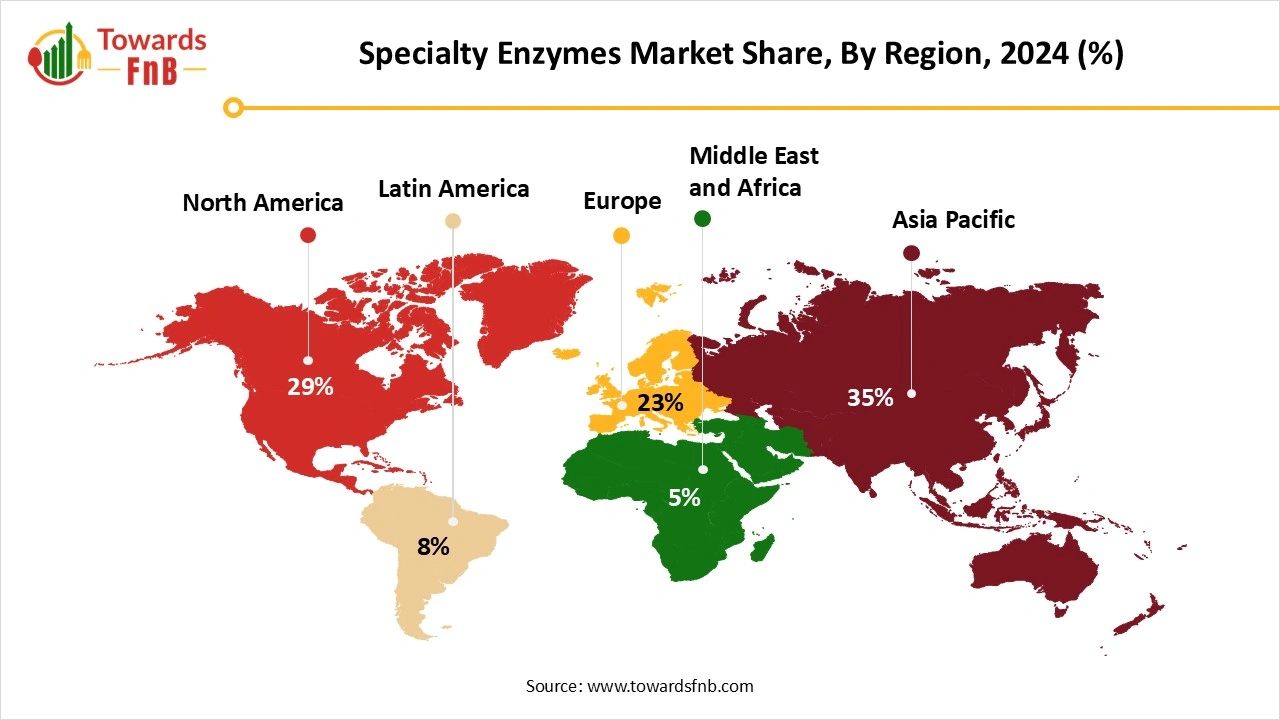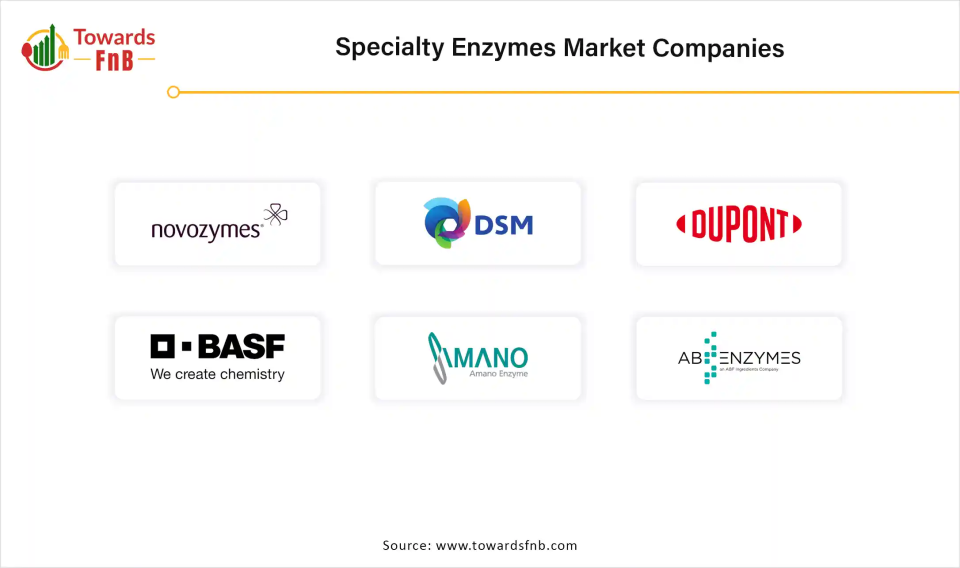November 2025
The global specialty enzymes market size reached at USD 6.20 billion in 2024 and is anticipated to increase from USD 6.73 billion in 2025 to an estimated USD 14.08 billion by 2034, witnessing a CAGR of 8.55% during the forecast period from 2025 to 2034. Growth of the market is due the growing pharmaceutical, diagnostic and food & beverages sector along with enzyme technology development.

| Study Coverage | Details |
| Growth Rate from 2025 to 2034 | CAGR of 8.55% |
| Market Size in 2025 | USD 6.73 Billion |
| Market Size in 2026 | USD 7.31 Billion |
| Market Size by 2034 | USD 14.08 Billion |
| Largest Market | Asia Pacific |
| Base Year | 2024 |
| Forecast Period | 2025 to 2034 |
| Regions Covered | North America, Europe, Asia-Pacific, Latin America, and Middle East & Africa |
Specialty enzymes market refers to the global market for enzymes that are tailored for niche or high-value applications, often exhibiting unique properties such as high specificity, stability under extreme conditions, or tailored catalytic activity, used across industries like pharmaceuticals, diagnostics, biofuels, food & beverages, animal feed, fine chemicals, leather, textile, and others.
Progress in the specialty enzymes sector highlights computational biology, artificial intelligence, nanozymes, safe biocatalysts, and molecular diagnostics. Nanozyme technology is primarily utilized in diagnostic and regenerative healthcare. AI and computational biology assist in the enhancement and identification of enzymes, promoting prompt progress. Improvements in industrial production techniques such as submerged liquid fermentation have enhanced enzyme yields. These technologies have benefited several other sectors including healthcare, industrial, and food and beverage industries. The expansion of the specialty enzymes market encourages the emergence of additional new businesses and industries. The possibility for creativity and growth offers chances for profit in various markets.
The manufacturing of specialty enzymes typically requires sophisticated biotechnological techniques, including recombinant DNA technology, protein engineering, and fermentation methods. These techniques demand cutting-edge tools and expert staff, which add to the total expense. For instance, the creation of recombinant enzymes requires genetically modified microorganisms that need to be meticulously grown, managed, and regulated to guarantee stable enzyme quality and performance. The elevated manufacturing expenses of specialty enzymes result in increased costs for end-users in sectors like pharmaceuticals, food and beverages, and biotechnology
Asia Pacific Dominated the Specialty Enzymes Market in 2024.
A major factor is the growing incidence of chronic and infectious diseases in the area, leading to heightened demand for precise diagnostic testing. Moreover, the growing healthcare infrastructure in countries such as China, India, and Japan has facilitated improved access to diagnostic services. The growth of the biotechnology and pharmaceutical sectors in the Asia Pacific region greatly contributes to the rising utilization of specialty enzymes. The rise in overseas investments in the area’s pharmaceutical industry is anticipated to create additional chances for specialty enzyme usage. Additionally, the increasing demand for processed food items, along with consumers' preference for high-quality products and natural ingredients, is fueling market expansion.
The specialty enzymes market in China is experiencing strong growth due to expanding industrial uses and a growing need for customized enzymatic solutions. China's growing biotechnology landscape, bolstered by government support and enhanced research infrastructure, establishes the market as an essential factor in the country's industrial and healthcare progress. China’s specialty enzymes industry is experiencing rapid innovation, marked by major progress in enzyme engineering and the optimization of bioprocesses.

North America Expects Significant Growth During the Forecast Period.
Pharmaceutical and diagnostic uses are essential growth sectors, driving the need for specialty enzymes in this area. Consumer awareness and health consciousness are additionally driving the market, especially for enzyme-enhanced consumer goods. Proteases and lipases are the primary growth catalysts in the U.S. market. Specialty enzymes are widely used across many sectors, such as biotechnology, food manufacturing, and agriculture.
The U.S. is projected to lead the North America market because of the strong demand for enzymes in the food & beverage industry, rising consumer health awareness, and an increasing preference for functional food. The U.S. specialty enzymes market is expected to experience significant expansion due to the substantial growth of the pharmaceutical and nutraceutical industries in the nation.
Which Type of Enzyme Dominated the Specialty Enzymes Market in 2024?
Proteases segment dominated the specialty enzymes market in 2024. A considerable demand is due to an increase in its applications within the pharmaceutical sector for therapeutic advantages, including anticancer, antimicrobial, and anti-inflammatory properties. The food processing sector has become a significant growth contributor, with protease enzymes essential for enhancing product quality and production efficiency. The growing need for processed and convenience foods has resulted in a higher use of protease enzymes in different uses, ranging from meat tenderization to baked goods. The continuous identification of specialized proteases, coupled with technological advancements, offers possibilities for market growth. With industries focusing on sustainable practices, proteases will remain vital catalysts in biological systems and industrial processes, ensuring consistent market growth in the future.
Polymerases & Nucleases Segment is Observed to Grow at the Fastest Rate During the Forecast Period.
Fueled by rising demand in various applications including biotechnology, molecular biology studies, and diagnostics. Nucleases are enzymes that break the phosphodiester links between nucleotides, crucial for DNA and RNA alteration in laboratory environments. The market is projected to expand in the next few years, driven by the rising need for DNA polymerases for sequencing purposes and the advancement of precision medicine. Additionally, major stakeholders are creating innovative and enhanced DNA polymerases that can improve the precision and pace of these applications, potentially increasing the market throughout the projected period.
Why did the Microbial-Derived Segment Dominate the Specialty Enzymes Market in 2024?
Microbial-derived segment dominated the market with the largest share in 2024. Microorganisms are regarded as excellent sources for enzyme production because they can generate enzymes in controlled environments, guaranteeing high yield and effectiveness. Moreover, the transition to biocatalysis in industrial uses has enhanced the market's significance by offering cleaner, more eco-friendly options compared to conventional chemical methods. Microbial sources, especially bacteria and fungi, are preferred for their capability to generate a variety of enzymes with different catalytic functions, rendering them ideal for many applications.
Recombinant/Genetically Engineered Enzymes Segment is Seen to Grow at a Notable Rate During the Predicted Timeframe.
The segment is undergoing swift expansion driven by various elements, such as heightened investment in biotechnology, growing demand in molecular biology, and a rising occurrence of genetic disorders. Moreover, the increasing need for personalized medicine and improvements in testing technologies like Next-Generation Sequencing (NGS) are driving market growth. A key benefit of recombinant enzymes is their capacity to be customized for applications. Scientists can change an enzyme's characteristics, like its stability, activity, or specificity, by altering the genetic sequence to better fit its intended use. This tailoring is especially advantageous in industrial operations, where enzymes must operate under challenging conditions such as severe pH levels or elevated temperatures.
Which Form Dominated the Specialty Enzymes Market in 2024?
Liquid enzyme preparations segment dominated the market with the largest share in 2024. The preference for liquid formulations in the market arises from their instant bioavailability and easy incorporation into manufacturing methods without the need for dissolution. Recent progress in stabilization technologies has enhanced the longevity of liquid enzymes, overcoming a significant historical constraint relative to dry formulations. The pharmaceutical industry is progressively employing liquid enzymes for drug development and production, aiding in market expansion.
Immobilized Enzyme Segment is Expected to Grow at the Fastest Rate in the Market During the Forecast Period.
This is since immobilized enzymes are extremely adaptable and possess numerous possible uses. Furthermore, the enzyme immobilization technique has been gradually refined over the years, resulting in a process that is now significantly easier, faster, and more efficient than in the past. This has acted as an additional motivating reason to employ this method. The capacity to isolate and reuse enzymes enables the production of diverse products; thus, immobilized enzymes are crucial for numerous markets in maintaining the availability of certain items for businesses and consumers. They are particularly significant in food processing and analysis. For example, food additives like high fructose corn syrup exemplify products made with immobilized enzymes.
Which End User Industry Dominated the Specialty Enzymes Market in 2024?
Food processing companies segment dominated the market in 2024. This expansion is fueled by a rising consumer inclination towards natural and clean-label food components. The widespread use of food enzymes has improved food quality, safety, and processing efficiency. Their request is being backed by a transition to healthier and more sustainable food production practices. Moreover, increased consumer awareness regarding healthy and nutritional foods has driven the use of specialty enzymes in diverse food items, improving digestion and nutrient uptake.
Bioenergy Producer's Segment is Observed to Grow at the Fastest Rate During the Forecast Period.
The increasing need for renewable energy sources, progress in enzyme technology, and heightened awareness of environmental concerns are some of the elements that have led to this trend. The increasing need for renewable energy sources is anticipated to influence the market size in various ways. Enzymes are essential in creating biofuels, which are renewable energy sources derived from organic materials like crops, waste, and wood chips. Utilizing enzymes can greatly enhance the efficiency and economic feasibility of biofuel generation, positioning them as a more practical substitute for fossil fuels, thus driving the expansion of the specialty enzymes market.
Raw Material Sourcing
Processing and Preservation
Quality Testing and Certification
Cold Chain Logistics and Storage
Biocatalysts Ltd
Inner Brightness
Novo Nordisk Pharmatech

By Type of Enzyme
By Source
By Form
By End-User Industry
By Region
The Indian sweeteners market size is projected to increase from USD 3.77 billion in 2025 to approximately USD 5.98 billion by 2034, registering a comp...
November 2025
November 2025
November 2025
November 2025